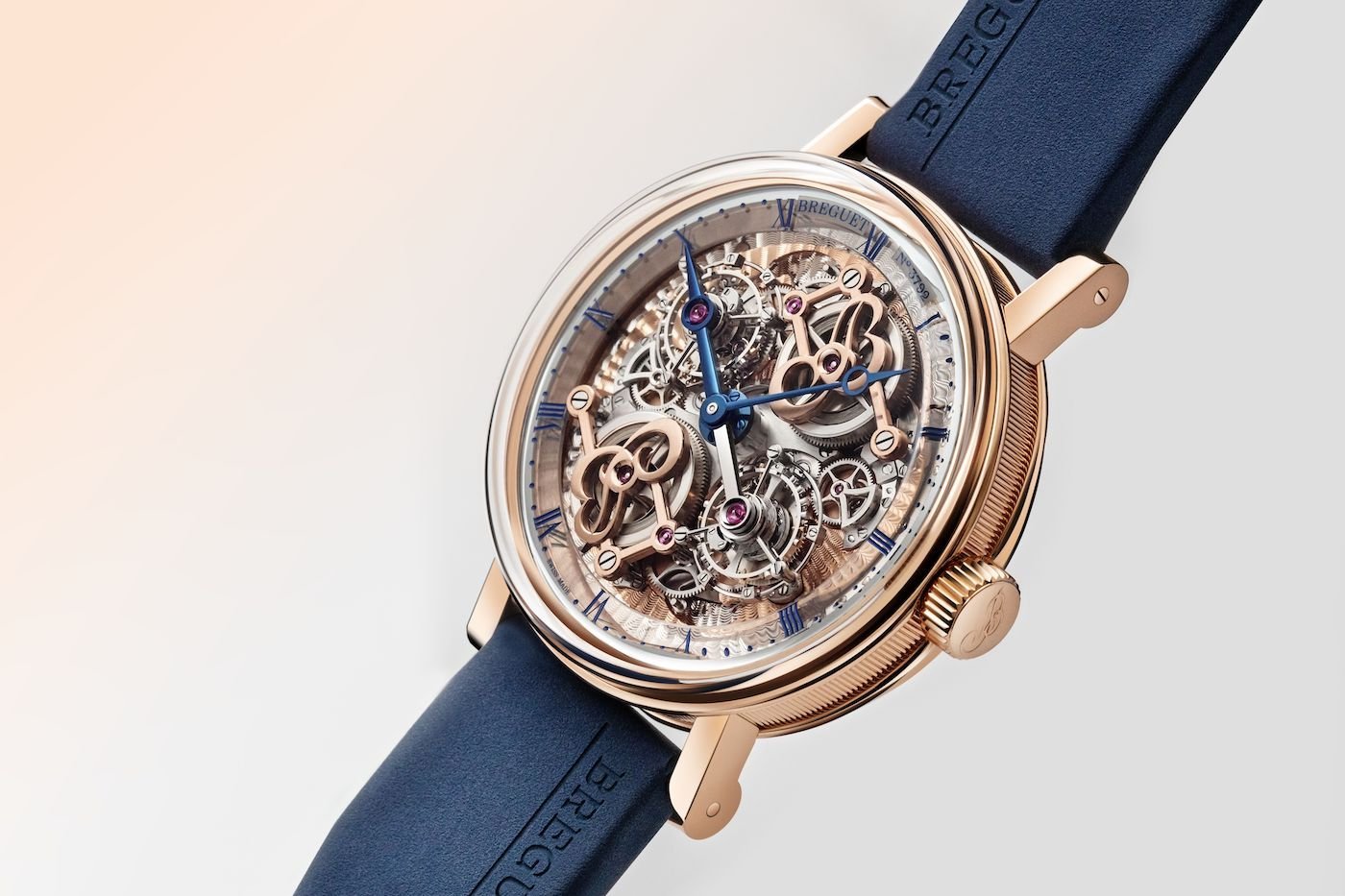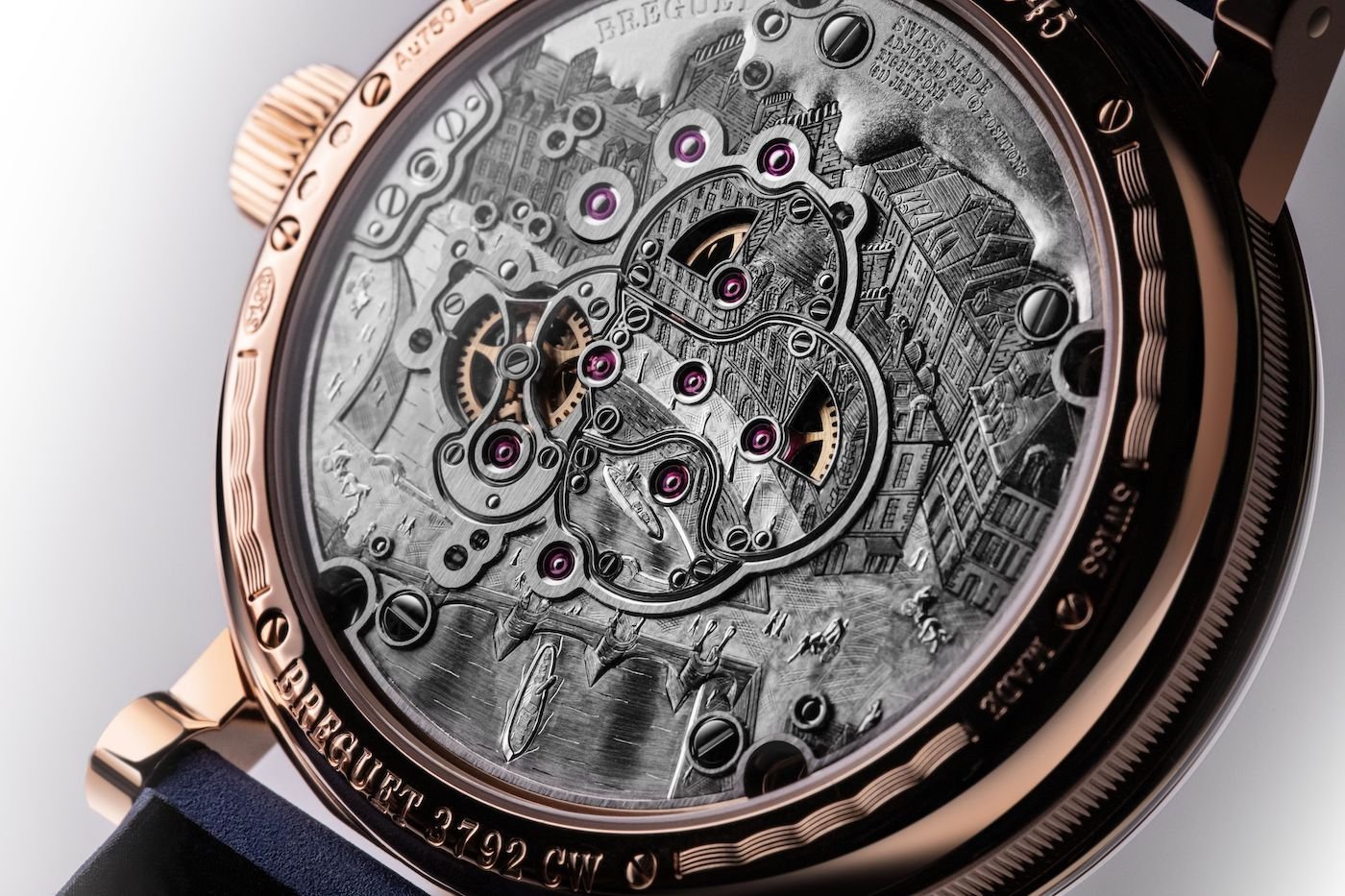n tribute to the brand founder’s invention on 26 June 1801, Breguet introduces a horological masterpiece blending expert skills with technical sophistication.
The sheer complexity of the 588N2 movement and its 740 components, housed in a rose gold case measuring 46 mm in diameter and 16.8 mm thick, vividly demonstrates the expertise required to create it. This masterpiece fascinates with the ingenuity of its mechanism. Viewing the watch from the dial reveals the intricate dance of two tourbillons, an integral part of the time display.
The bar of these two tourbillons is attached to a central mainplate rotating every 12 hours thanks to a particularly complex mechanism. The designers were naturally able to attribute an additional function to this component by transforming it into an hours hand in the brand’s characteristic style.
Each equipped with its own gear train powered by its own barrel, the two tourbillons independently make one full turn per minute. The two mechanisms are connected to a central differential regulating the rate of the watch and, via a third gear train, driving the rotation of the entire mechanism.
The sapphire dial is equally impressive, bearing Roman numerals and an engraved minutes track. A blue varnish has been applied to these interstices, creating the impression of the chapter ring being suspended above the mechanism. The vertical flank of the caseband is engraved with 12 Roman numeral hour-markers. These are then coated with black varnish, representing the shadow of the chapter ring numerals.
The timepiece is paired with a Breguet-embossed midnight blue rubber strap.
This exceptional timepiece is a wrist-worn work of art, incorporating several different artistic crafts within the same watch.
In its atelier dedicated to this craft, the Manufacture has created an entirely new guilloché pattern for this timepiece: radiant flinqué, a motif visually reminiscent of regular sound waves. This decoration is applied to the rose gold rotating mainplate and to the rhodium-plated gold bridge below it. A true Breguet signature, guilloché work is an art perpetuated on almost 30 guilloché lathes, making it one of the most important such workshops in the entire watch industry. While the new guilloché lathes are crafted within the Manufacture, the historical ones – some dating from the 18th century – are purchased from private individuals and companies around the world who are not using them. All are restored by specialist in-house mechanics and put back into service in the workshops. Each guilloché lathe has its own specific features and can produce different types of decoration, some straight and others circular. Guilloché artisans are trained and thus capable of executing a wide variety of geometric motifs. At Breguet, almost all watches are adorned with a guilloché pattern, whether on the dial, case, oscillating weight, mainplate or bridges.
Other decorations can be admired on the dial. These include the mirror polishing on the tourbillon cages, the sunburst pattern on the minutes track, the snailing on the differential bridge, the circular satin-finish on the gears and barrels, as well as the circular graining on the underside of the rotating mainplate.
More than a hundred hours were needed to create the engraving on the back of the movement. The intricacy of the engraved details is an invitation to focus on the place where the Breguet brand was born. Hand-engraved by the Manufacture’s artisans, the depiction features an aerial view of Abraham-Louis Breguet’s workshop at 39 Quai de l’Horloge. Various techniques were used to create perspective effects on a gold plate, notably including bas-relief engraving that involves hollowing out the material. The tracing tip was used to create fine lines on the asphalt, while grey contrasts were created using black and white rhodium. These colours are also found in the galvanic treatment used to coat the bridges.
Breguet’s artisan engravers have acquired an extraordinary ability to respect the brand’s artistic aesthetic, while retaining their personal touch that is an essential asset in all craftsmanship. Engraving, relief engraving, and intaglio engraving are among the methods most regularly used.
At Breguet, every tiny part of the movement, even those that are invisible, is chamfered and polished. The new double tourbillon is no exception to the rule.

A multitude of interior and exterior angles have been crafted by hand. A true token of Haute Horlogerie excellence involving over 100 hours of work on this mechanism, this method offers a pure and distinctive aesthetic finish demonstrating a precision that no machine can currently match.
The barrel bridges recalling the Breguet “B” are satin-brushed and feature a rounded-off polish known as poli-bercé. Several of the techniques used by the hand-chamfers have been applied to the various components to give them an exceptional finish. These include polished angles, satin-brushed flanks, straight graining and poli-bercé, which can be admired on almost the entire movement.
Also known as bevelling, chamfering is a complex process that has been raised to an art form by Breguet. This technique, requiring great dexterity, consists in filing down the sharp edges of the various components, highlighting their outline while creating luminous shimmering effects. The polish should have a uniform sheen, with no twists or facets. Finally, the interior angles must feature a clean line, formed at the point where the two chamfers meet. Since tuition courses for this exceptional craft have all but disappeared, Breguet is committed to training future chamfering experts in-house to perpetuate this art. The artisans use various tools including files, buffs, and sticks made of various types of wood. These are all adapted by the master chamferer to the individual components.

TECHNICAL SPECIFICATIONS
Reference 5345BR/1S/5XU
- Case: 18K rose gold case, sapphire-crystal back, vertical flank of the caseband engraved with 12 Roman numerals, filled with black varnish
- Size: 46 mm
- Dial: sapphire, Roman numerals and minutes track engraved and coated with blue varnish, chapter ring on sapphire disc
- Hands: blued steel hours hand serving as the upper bridge of one of the tourbillons, while its extension is used for the second tourbillon
- Functions: hours, minutes
- Escapement: pin-lever escapement and Breguet balance spring
- Movement: double Tourbillon, in gold, hand-wound, hand-guilloché and engraved mainplate
- Calibre: 588N2
- Frequency: 2.5 Hz
- Power reserve: 60 hours
- Strap: midnight blue rubber









